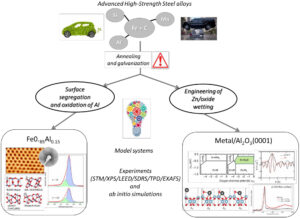The environmental constraints of lightening cars, to reduce CO2 emissions from internal combustion engines or to increase the range of electric cars, are pushing steelmakers to develop new grades of Advanced High-Strength Steel (AHSS) enriched with light alloying elements (Al, Mn, Si). During the recrystallization annealing of the plates after rolling the slabs, these very electropositive alloying elements tend to segregate on the surface and oxidize, despite the furnace atmosphere which allows the reduction of iron oxides. Due to the poor metal/oxide wetting, these surface oxides of alumina or silica are detrimental to the subsequent adhesion of the sacrificial zinc anticorrosion coating. To overcome this problem in continuous hot-dip galvanizing lines where the steel strip is dipped directly into a molten zinc bath, manufacturers have developed vacuum zinc deposition technologies (Jet Vapor Deposition). Faced with these adhesion problems, two strategies are possible:
- To find levers of action to promote wetting on existing oxides;
- To better understand the oxidation processes in order to move from an external process to an internal process to promote zinc/steel contact.
In this very general context and in close collaboration with ArcelorMittal-Maizières-Research, the “Low Dimensional Oxides” team of INSP brings all its know-how on these interface engineering problems by exploring the underlying fundamental concepts on well-chosen model systems.
The role of environment, polarity, termination, surface hydroxylation [T1,P1,1,3] and transition metal buffer layers [T2,P1,2,4,8,B1] on the wetting behavior of zinc on -Al2O3(0001) surfaces has been explored both experimentally and theoretically. Situations for which the failure changes from interfacial to cohesive have been isolated and rationalized on the basis of ab initio calculations. These concepts have been generalized to the case of silicates [P2,9]. On Fe0.85Al0.15 model crystals of a composition representative of ferritic alloy steels, the effects of orientation [(110),(100),(111)] and environment on the tendency to segregation and surface oxidation have been addressed through a surface science approach combining microscopy, diffraction and photoemission [T3,P3,5,7,10,12]. In parallel, theorists have undertaken a systematic exploration of the richness of the structures of ultra-thin alumina films [P3,11,12]. The idea is to understand the elementary building blocks of these oxides and the transition towards the formation of thicker films of -Al2O3 as observed on industrial steels.

Figure : approach of physical chemistry of interfaces followed at the INSP on the problem of galvanization of alloyed steels used for the lightening of automobiles.
Thesis
[T1] 2011-2014 : Rémi Cavallotti, CIFRE thesis, Effects of α-alumina termination on the wetting behavior of zinc
[T2] 2015-2018 : Maya Messaykeh, LabEx Matisse thesis, A fundamental approach of the wetting at Zn/Al2O3 interface: the effect of a Cr buffer
[T3] 2014-2016 : Zongbei Dai, Orientation-dependent segregation and oxidation at Fe0.85Al0.15 random alloy surfaces
Post-docs
[P1] 2016-2018 : Ha-Linh Thi Le, ArcelorMittal financing
[P2] 2018-2020 : Jacopo Baima, ArcelorMittal financing
[P3] 2019-2020 : Natalia Alyabyeva and Maxime Van Den Bosche, ANR Surfox
Publications
[1] Rémi Cavallotti, Jacek Goniakowski, Rémi Lazzari, Jacques Jupille, Alexey Koltsov, and Didier Loison.Role of Surface Hydroxyl Groups on Zinc Adsorption Characteristics on α-Al2O3(0001) Surfaces: First-Principles Study.The Journal of Physical Chemistry C 2014 118 (25), 13578-13589. DOI: 10.1021/jp501318p
[2] Rémi Cavallotti, Ha-Linh Thi Le, Jacek Goniakowski, Rémi Lazzari, Jacques Jupille, et al.. New routes for improving adhesion at the metal/α-Al2O3(0001) interface. Physical Chemistry Chemical Physics, Royal Society of Chemistry, 2015, 18 (4), pp.3032-3039. ⟨10.1039/C5CP06435J⟩. ⟨hal-01263694⟩
[3] Ha-Linh Thi Le, Remi Lazzari, Jacek Goniakowski, Remi Cavallotti, Stephane Chenot, et al.. Tun- ing Adhesion at Metal/Oxide Interfaces by Surface Hydroxylation. Journal of Physical Chemistry C, American Chemical Society, 2017, 121 (21), pp.11464-11471. 10.1021/acs.jpcc.7b02456 . hal- 01520408
[4] Ha-Linh Thi Le, Jacek Goniakowski, Claudine Noguera, Alexey Koltsov, Jean-Michel Mataigne. Improving Adhesion at the Alumina/Zinc Interface by Stainless Steel Buffers. Journal of Physical Chemistry C, American Chemical Society, 2017, 121 (45), pp.25143-25151. ⟨10.1021/acs.jpcc.7b07112⟩. ⟨hal-01651879⟩
[5] Zongbei Dai, Patrizia Borghetti, Younes Mouchaal, Stephane Chenot, Pascal David, et al.. Self- organized carbon-rich stripe formation from competitive carbon and aluminium segregation at Fe 0.85 Al 0.15 (1 1 0) surfaces. Applied Surface Science, Elsevier, 2018, 444, pp.457-466.10.1016/j.apsusc.2018.03.084 . hal-01789678
[6] Ha-Linh Thi Le, Jacek Goniakowski, Claudine Noguera, Alexey Koltsov, Jean-Michel Mataigne. Role of surface hydroxylation on adhesion at zinc/silica interfaces. Physical Chemistry Chemical Physics, Royal Society of Chemistry, 2018, 20 (22), pp.15581 – 15588. 10.1039/C8CP02139B . hal-01911235
[7] Zongbei Dai, Patrizia Borghetti, Stéphane Chenot, Pascal David, Alexey Koltsov, et al.. Aluminium segregation profiles in the (110), (100) and (111) surface regions of the Fe 0.85 Al 0.15 random body-centered cubic alloy. Applied Surface Science, Elsevier, 2019, 492, pp.886-895. 10.1016/j.apsusc.2019.06.235 . hal-02340100
[8] Maya Messaykeh, Jacek Goniakowski, Gregory Cabailh, Jacques Jupille, Rémi Lazzari, et al.. Chromium Adsorption Reveals a Persistent Hydroxylation of Vacuum-Annealed α-Al 2 O 3 (0001). Journal of Physical Chemistry C, American Chemical Society, 2019, 123 (48), pp.29245-29254. ⟨10.1021/acs.jpcc.9b08907⟩. ⟨hal-02452290⟩
[9] Jacopo Baima, Jacek Goniakowski, Claudine Noguera, Alexey Koltsov, Jean-Michel Mataigne. Surface thermodynamics of silicate compounds: the case of Zn 2 SiO 4 (001) surfaces and thin films. Physical Chemistry Chemical Physics, Royal Society of Chemistry, 2019, 21 (24), pp.13287-13295. ⟨10.1039/C9CP02039J⟩. ⟨hal-02374563⟩
[10] Zongbei Dai, Natalia Alyabyeva, Patrizia Borghetti, Stéphane Chenot, Pascal David, et al.. Al-rich Fe0.85 Al0.15 (100), (110) and (111) surface structures. Applied Surface Science, Elsevier, 2020, 509, pp.145312. ⟨10.1016/j.apsusc.2020.145312⟩. ⟨hal-02451294⟩
[11] Jacek Goniakowski, Maxime van den Bossche, Claudine Noguera. Understanding the structural diversity of freestand- ing Al 2 O 3 ultrathin films through a DFTB-aided genetic algorithm †. Nanoscale, Royal Society of Chemistry, 2020, 12 (10), pp.6153-6163. ⟨10.1039/C9NR10487A⟩. ⟨hal-02986270⟩
[12] Zongbei Dai, Natalia Alyabyeva, Maxime van den Bossche, Patrizia Borghetti, Stéphane Chenot, et al.. The Oxide at the Al-rich Fe 0.85 Al 0.15 ( 110 ) surface. Physical Review Materials, American Physical Society, 2020, 4 (7), ⟨10.1103/PhysRevMaterials.4.074409⟩. ⟨hal-02928089⟩
Patent
[B1] A coated metallic substrate and fabrication method, PCT/IB2017/000668, Inventeurs : Arcelor-Mittal, UPMC-CNRS (2017)

